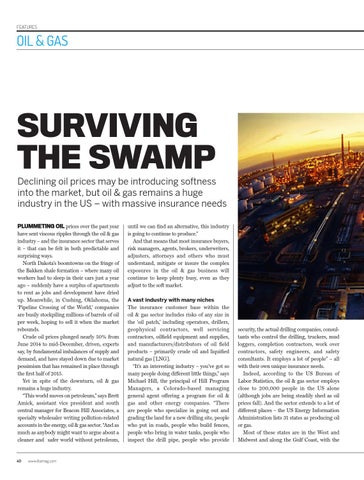FEATURES
OIL & GAS
SURVIVING THE SWAMP Declining oil prices may be introducing softness into the market, but oil & gas remains a huge industry in the US – with massive insurance needs PLUMMETING OIL prices over the past year have sent viscous ripples through the oil & gas industry – and the insurance sector that serves it – that can be felt in both predictable and surprising ways. North Dakota’s boomtowns on the fringe of the Bakken shale formation – where many oil workers had to sleep in their cars just a year ago – suddenly have a surplus of apartments to rent as jobs and development have dried up. Meanwhile, in Cushing, Oklahoma, the ‘Pipeline Crossing of the World,’ companies are busily stockpiling millions of barrels of oil per week, hoping to sell it when the market rebounds. Crude oil prices plunged nearly 50% from June 2014 to mid-December, driven, experts say, by fundamental imbalances of supply and demand, and have stayed down due to market pessimism that has remained in place through the first half of 2015. Yet in spite of the downturn, oil & gas remains a huge industry. “This world moves on petroleum,” says Brett Amick, assistant vice president and south central manager for Beacon Hill Associates, a specialty wholesaler writing pollution-related accounts in the energy, oil & gas sector. “And as much as anybody might want to argue about a cleaner and safer world without petroleum,
40
until we can find an alternative, this industry is going to continue to produce.” And that means that most insurance buyers, risk managers, agents, brokers, underwriters, adjusters, attorneys and others who must understand, mitigate or insure the complex exposures in the oil & gas business will continue to keep plenty busy, even as they adjust to the soft market.
A vast industry with many niches The insurance customer base within the oil & gas sector includes risks of any size in the ‘oil patch,’ including operators, drillers, geophysical contractors, well servicing contractors, oilfield equipment and supplies, and manufacturers/distributors of oil field products – primarily crude oil and liquified natural gas [LNG]. “It’s an interesting industry – you’ve got so many people doing different little things,” says Michael Hill, the principal of Hill Program Managers, a Colorado-based managing general agent offering a program for oil & gas and other energy companies. “There are people who specialize in going out and grading the land for a new drilling site, people who put in roads, people who build fences, people who bring in water tanks, people who inspect the drill pipe, people who provide
security, the actual drilling companies, consultants who control the drilling, truckers, mud loggers, completion contractors, work over contractors, safety engineers, and safety consultants. It employs a lot of people” – all with their own unique insurance needs. Indeed, according to the US Bureau of Labor Statistics, the oil & gas sector employs close to 200,000 people in the US alone (although jobs are being steadily shed as oil prices fall). And the sector extends to a lot of different places – the US Energy Information Administration lists 31 states as producing oil or gas. Most of these states are in the West and Midwest and along the Gulf Coast, with the
www.ibamag.com
40-43_Ad Led Oil & Gas-SUBBED.indd 40
29/05/2015 5:16:32 AM
